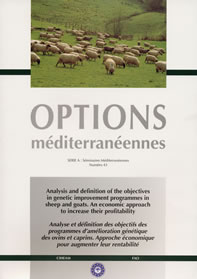| Article précédent | p. 129-136 |
A steering frame for the genetic improvement of sheep and goats in Tunisia
The genetic heritage of sheep and goats in Tunisia is rich and diverse with a population of around 4 million breeding ewes and 800 thousand breeding goats. More than 80 per cent of the sheep and goat stock are raised in generally mixed (sheep and goats), small-sized flocks under very extensive conditions. Moreover, social-economic mutations have raised new production systems, new consumption trends hence, new objectives of selection. In a situation already marked by the diversity of the production conditions with a further rapid mutation, the definition of breeding objectives is a difficult, not straightforward task. Based on the technical results of breeds characterisation, the present paper develops a number of ideas in relation to the future prospects of sheep and goats genetic improvement bearing in mind the above listed constraints and in the expectation of the social-economic evolutions ahead of this production area.
- [ Afficher ]
- [ Télécharger ]
- [ Exporter la citation ]
Vous pouvez télécharger la citation au format :
- [ Imprimer ]
-
Mots-clés
AMELIORATION DES ANIMAUX, CAPRIN, OVIN, TUNISIECiter cet article
Rekik M., Ben Hammouda M. A steering frame for the genetic improvement of sheep and goats in Tunisia. In : Gabiña D. (ed.). Analysis and definition of the objectives in genetic improvement programmes in sheep and goats. An economic approach to increase their profitability . Zaragoza : CIHEAM, 2000. p. 129-136. (Options Méditerranéennes : Série A. Séminaires Méditerranéens; n. 43). Meeting of the Sub-Network on Genetic Resources of the FAO-CIHEAM Inter-Regional Cooperative Research and Development Network on Sheep and Goats, 1999/11/18-20, Zaragoza (Spain). http://om.ciheam.org/om/pdf/a43/00600478.pdf



